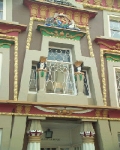- Latest Archaeology Updates
- Importance and applicability
- Famous Archaeologists
- Museums Collections
- Site Map
- World Heritage Sites
- World History Monuments
- Archaeological Organizations
- World Atlas of Archaeology
- Forensic Investigation and Geophysics
- Contact Us
- Movies based on Archaeology
- Frequently Asked Questions
- Archaeological discoveries
- Tell a Friend
- Archaeological Abbreviations
- Gallery Collections
- Famous-Museums site map
- Famous-archaeologists site map
- Archaeological Monuments site map
The geological history of Egypt as indicated by it's fauna and flora is displayed in the Museum. There is also the unique collection of the Fayoum vertebrate fossils on display and a large collection of minerals, ores and rocks.In addition, a very valuable collection of meteorites discovered in Egypt and from other places in the world are displayed. These include the famous Egyptian meteorite Nakhlite believed to be from Mars.
The Museum is served by a library with references that date as far back as 1778, in addition to up to date references and bibliographies. These are available to the public and scientists. The Museum also includes some specialized laboratories for mineralogical, petrological and paleontological (both vertebrate and invertebrate) studies.
Models for rare vertebrate fossils are made to facilitate detailed studies and preserve the original specimens. The Museum shares in the studies conducted on the protectorates and outstanding geological features in order to raise the public environmental awareness.
The Egyptian Geological Museum is one of the oldest and most important geological museums in the world. It is located in Cairo, Egypt and was established in 1891. The museum houses a comprehensive collection of rocks, minerals, fossils and artifacts, as well as geological maps and documents. It is the largest geological museum in the Middle East and is a major center for research and education. The museum was founded by renowned geologist and paleontologist, Professor Karl von Zittel, who was a professor at the University of Leipzig in Germany. Zittel was a pioneer in the field of geology and was an important influence in the development of the modern science of geology. He was also a major contributor to the development of the field of paleontology. The museum is organized into several departments, each dedicated to a different aspect of geology. The first department is the Historical Geology Department, which houses a collection of fossils, rocks, minerals and artifacts from different geological periods. The second department is the Mineralogy and Petrography Department, which houses a collection of minerals, rocks, and fossils from different geological periods. The third department is the Geotechnical Engineering Department, which is responsible for the design and construction of geotechnical structures. The museum also contains several other departments, including a laboratory for analyzing rocks and minerals, a library, a lecture hall, a research library and a teaching laboratory. The museum is open to the public and has several exhibitions, educational programs and guided tours. The museum has a long history of research and education. It has been involved in many important geological discoveries, such as the discovery of the oldest fossilized dinosaur in Egypt, the discovery of the oldest known fossilized human remains in the Middle East, and the discovery of the oldest known dinosaur in Africa. The museum also serves as a major center for research and education in the field of geology.

